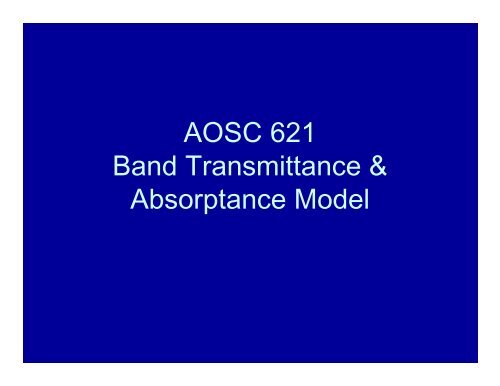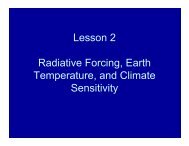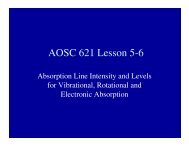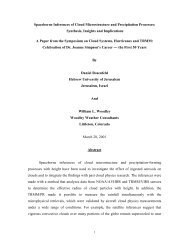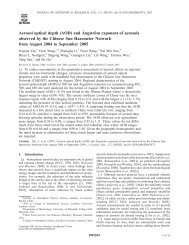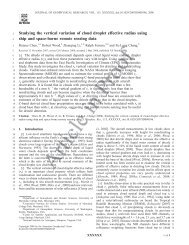Lesson14 Band Model.pdf
Lesson14 Band Model.pdf
Lesson14 Band Model.pdf
- No tags were found...
You also want an ePaper? Increase the reach of your titles
YUMPU automatically turns print PDFs into web optimized ePapers that Google loves.
Schematic for A
Absorption in a Lorentz line shape
Transmission in spectrally complex media• Consider a single line with a Lorentz line shape.• As u gets larger the absorptance gets larger. However asu increases the center of the line absorbs all of theradiation, while the wings absorb b only some of theradiation.• At tthis spoint tonly ythe ewings absorb.b.• We can write the band transmittance as;T1 Su Ld exp 2 (( 0)L)
Non-overlapping overlapping linesThe mean spectral beam transmittance and absorptance of an isolated line is:T b 1 exp[ m( % )u] d % % % b 1 1 exp[ m( %)u] d % % %If n lines within %contribute to the absorption at a particular wavenumber: m( %) nj mj 1( %)If there is no overlap, total absorptance isW nnW j 1 exp[ j m( %)u]j 1 j 1 % d %n
Influence of overlapConsider two identical lines within % . When completely separated:W 2 1 exp[ m( %)u] d % %When perfectly superimposed:W 1 exp[2 m( %)u] d % %If several lines contribute to the transmittance (absorptance) at a particularwavenumber , the total transmittance is the product of transmittances: njT b( %) exp[ m( %)u j] exp[ j jm( %)u j] T bj 1j 1j 1nn8
Line-By-Line (LBL) modelsMonochromatic optical path along inhomogeneous path:nnj( %) m( %, u )du m( %, p,T ) du S j( %,T )( %, p,T ) du uu j 1u j 1Need to resolve individual lines!The average spectral beam transmittance is: 1 %Mi1exp Lnl 1j 1 mj( % i, p l,T l)u l % iwhen broken to smaller paths that can beconsidered homogeneousLots of calculations!9
Transmission in spectrally complex media• Let be large enough to include all of the line,then we can extend the limits of the integration to±∞.• Landenburg and Reichle showed that1 xT 1 ( ) ( ) e J0ix iJ1ixSuwhere x J 0and J1are Bessel2 Lfunctions
Transmission in spectrally complex media• For small x , known as the optically thin condition,SuT 1for large x, optically thick,T2Su112x2 SuL
Elsasser band model
Elsasser <strong>Band</strong> <strong>Model</strong>• Elsasser and Culbertson (1960) assumed evenlyspaced lines (d apart) of equal S that overlapped.They showed that the transmittance could beexpressed asT exp ycoth( ) J0(iy sinh( )) dywhere optically thinT2LdandSu1-T 1-dySud sinh( )optically thick2d SuL
Statistical <strong>Band</strong> <strong>Model</strong> (Goody)• Goody studied the water-vapor bands and noted theapparent random line positions and band strengths.• Let us assume that the interval contains n linesof mean separation d, i.e. =nd• Let the probability that line i has a line strength S ibe P(S i ) where0P(S)dS1• P is normally assumed to have a Poisson• P is normally assumed to have a Poissondistributioni
Statistical <strong>Band</strong> <strong>Model</strong> (Goody)• For any line the most probable value of S isgiven bySP( S)dSS0 0 )0P( S dS• The transmission T over an interval is givenbyTi01 d P(Si)ekiudSi
Statistical <strong>Band</strong> <strong>Model</strong> (Goody)• For n lines the total transmission T is given byT=T 1 T 2 T 3 T 4 …………..T nTxTA01()P(Snd 1d1................. dku21) e dS ku1P(S2)e dS2........ P(Sn)001 dn ( ) 0 111 knue dSd 0P(S)ekuP( S)(1 edS kun) dSnn1
Statistical <strong>Band</strong> <strong>Model</strong> (Goody)The equation can be further simplified to 1T exp d P( S)(1 edoassuming a Lorentz line shape, p,Texp ep where Sis1/2Su Su 1d L kuthe mean line strength.) dSone gets
Statistical <strong>Band</strong> <strong>Model</strong> (Goody)• We have reduced the parameters needed to calculateT to twoSdandLd• These two parameters are either derived byfitting the values of T obtained from a line-by-linecalculation, or from experimental data.Tweak line expSu d Tstrong line exp LSud
Summary of band models
K-Distribution Method: the conceptChoices for calculating spectral average beam transmittances:1. Line-by-Line (LBL): accurate, but lots of CPU2. <strong>Band</strong> models: fast, but not so accurate3. k-distribution: fast, with acceptable accuracyThe basic idea behind the k-distribution% 2 T b(u) 1L k( % )u 1 k( % )ue % d % e% %2 1% d % e kl u % l1% l 1 %Same (approximate) value of is encountered many times!20
The concept (continued)The average beam spectral transmittance can be writtenT b(u) NoteNj 1f (k j)e k juk jk maxk minf (k)dk 121
Cumulative distributions and integral formsNow, let’s define a cumulative distribution such that:m k j g(k N) g(k max) f (k j)g(k m) f (k j)j 1N k j 1NThen: T b(u) f (k j)e k Nju k j g(k j)e k Nju g je k juIn the limit of j 1j 1 j 1 j 1T b(u) 1dge k(g)u0 where g(k) f ( k )dkk022
Example 29.6 µm band of O 3 at30 mb23


